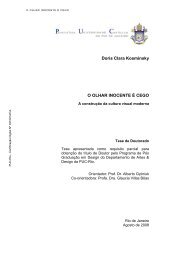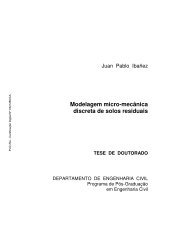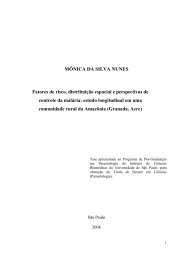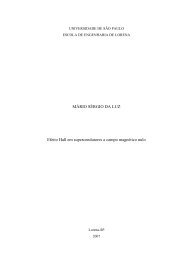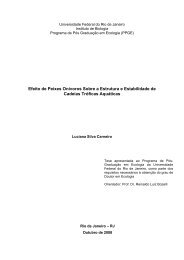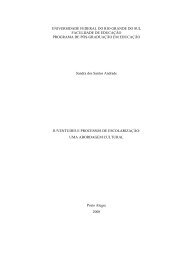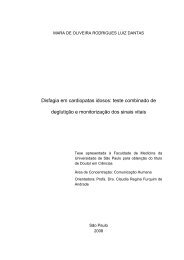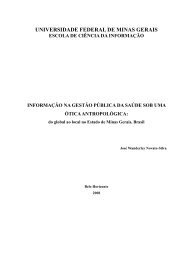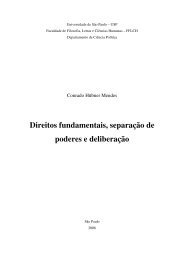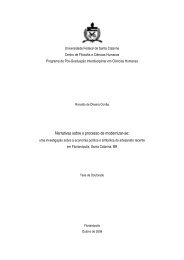Create successful ePaper yourself
Turn your PDF publications into a flip-book with our unique Google optimized e-Paper software.
1044 D.A.R. Magalhães et al. / Molecular Immunology 42 (2005) 1043–1048The timing of T-cell maturation during thymus ontogenyis different among inbred mouse strains, strongly suggestinga role for the <strong>gene</strong>tic background in the modulation ofthis phenomenon (Junta and Passos, 1998; Mace<strong>do</strong> et al.,1999).Using the reverse-transcription-PCR (RT-PCR) methodwe have previously found that several immune system-related<strong>gene</strong>s such as interleukins and the major histocompatibilitycomplex (MHC) are differentially expressed during thymusontogeny of inbred mouse strains (Espanhol et al., 2003).Although the knockout mice have been used as a valuabletool for defining the role of a set of immune system-related<strong>gene</strong>s (Mak et al., 2001), non-manipulated mouse strains stillconstitute a classical model-system useful for studies on thein vivo modulation of several other <strong>gene</strong>s acting in cascadeduring thymocyte development.The new functional genomic technology using the cDNAmicroarray method provides the opportunity to perform acomparative analysis between the different phases of the thymusontogeny, yielding quantitative expression data of hundredsor thousands of <strong>gene</strong>s in a single experiment.The early fetal thymus has homo<strong>gene</strong>ous cell populationscomposed of <strong>do</strong>uble negative (DN) thymocytes, whose proportionchanges to <strong>do</strong>uble positive (DP) in the late stages offetal development. In contrast, the newborn and adult thymusis the place of arrival of new colonizing precursors, whichcontribute to the formation of hetero<strong>gene</strong>ous cell populationsincluding macrophages and dendritic cells (Shortmanand Wu, 1996).In this study, we evaluated the dynamic transcriptionalprofile of thymus development observed during the gestationalperiod of (Balb-c × C57Bl/6) F 1 hybrid mice usinga set of two nylon cDNA microarrays containing a total of1,576 thymus IMAGE sequences. Each phase of thymus developmentexhibited a characteristic <strong>gene</strong> expression patterninvolving <strong>gene</strong>s of known functions, permiting the identificationof those implicated in the T-cell signaling pathway andexpressed sequence tags (ESTs) whose functions are still unknown.The differentially and significantly expressed <strong>gene</strong>sand ESTs observed here may be considered as novel markerscharacterizing individual stages of thymus ontogeny.2. Material and methods2.1. Fetal thymus, RNA and DNA preparationThe (Balb-c × C57Bl/6) F 1 hybrid mice were obtained inour own animal facilities. Pregnant Balb-c females were sacrificedby ether inhalation and the fetuses were surgicallycollected from the uterus. The age of the fetus (in days postcoitum, p.c.) was confirmed on the basis of the morphologicalcharacteristics of each development phase (Rugh, 1968).Fetal thymus tissue (1 mg containing approximately1 × 10 7 cells) was obtained by surgery under a stereomicroscopeand immediately processed for total RNA and genomicDNA extractions using Trizol ® reagent, following the manufacturer’sinstructions (Invitrogen).2.2. TRBV8.1-BD2.1 recombination assayT-cell maturation was monitored by detection of rearrangementsbetween segments TRBV8.1-BD2.1 during thymusdevelopment using PCR (Muegge et al., 1993). Theoligonucleotide primers were the VB8.1 forward primer(primer 1, GAGGCTGCAGTCACCCAAAGTCCAA) theVB8.1 reverse primer (primer 2, ACAGAAATATACAGCT-GTCTGAGAA), and the JB2.1 reverse primer (primer 3,TGAGTCGTGTTCCTGGTCCGAAGAA). The PCR reactionmixture contained 35 mM Tris (pH 8.3), 50 mM KCl,2.5 mM MgCl 2 , bovine serum albumin (100 g/ml), nucleotidetriphosphates (NTPs) (2 M each), the primers(0.5 M each), 1 U Taq polymerase (Amersham Biosciences,Buckinghamshire, England), with a constant amount of genomicDNA (1 g) from each developmental stage. The PCRprogram consisted of 30 cycles (1 min at 94 ◦ C, 2.5 min at54 ◦ C, and 1.5 min at 70 ◦ C, with a 7-min extension period).The PCR product obtained with primers 1 and 3 wasresolved on 1.2% agarose gel and blotted on HybondNylon + (Amersham Biosciences). The rearranged VB8.1-DB2.1 330 bp segment was detected by Southern hybridizationwith the 32 P-labeled PCR product of 100 bp obtainedwith primers 1 and 2, and visualized using a phosphor imagersystem (Cyclone, Packard Co. USA).2.3. cDNA-microarray methodWe used a pair of cDNA microarrays containing a totalof 1,576 clones in the form of PCR products, spottedin duplicate on 2.5 × 7.5 cm Hybond N+ nylon membranes(Amersham Biosciences). The arrays were prepared in ourlaboratory using a Generation III Array Spotter (Amersham-Molecular Dynamics). A complete file providing all <strong>gene</strong>spresent in the microarrays used in this study is available online at http://rge.fmrp.usp.br/passos/nylon array/mtb1.Mouse EST cDNA clones were obtained from theSoares thymus 2NbMT normalized library, prepared froma C57Bl/6J 4-week-old male thymus, and available in theI.M.A.G.E. Consortium (http://image.llnl.gov/image/html/iresources.shtml).cDNA inserts were homo<strong>gene</strong>ous in size (near 1 Kb)and cloned in three vectors (pT7T3D, pBluescript andLafmid) and were amplified in 384- or 96-well plates usingvector-PCR amplification with the following primers,which recognize the three vectors, LBP 1S 5 ′ -GTGGAA-TTGTGAGCGGATACC-3 ′ forward and LBP 1AS 5 ′ -GCAAGGCGATTAAGTTGG-3 ′ reverse.The membranes were first hybridized with the LBP1AS [- 33 P]dCTP (Amersham Biosciences) labeled oligonucleotide(vector hybridization). Quantification of the obtainedsignals allowed the estimation of the amount of DNA



